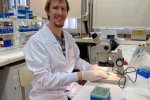category_news
Viral journey unfolded in buzzing world of Black Soldier Flies (BSF)
Keeping things on the fly, the focus on BSF infecting pathogens has expanded rapidly. Once thought to be invincible against pathogens, BSF are revealing their vulnerabilities, prompting a deeper dive into their health and rearing practices. So…what is the next step?
Research on BSF and pathogens has begun to kick-off over the last 3 years. Multiple publications have shown the potential of some bacteria and fungi to cause signs and symptoms of disease in BSF under certain laboratory conditions. In line with this, this year it has come to light that one of the problems observed in industrial BSF rearing can be caused by a bacteria, Paenibacillus thiaminolyticus.
Adding a twist to the tale, in the last year two separate studies, one by the Insect Doctors program and another by US researchers have spotlighted viruses linked to BSF. While we only introduced one of the virus candidates that we were characterizing at the time, together, the list of viruses associated with BSF now stands at eight. In addition, viral-like elements (“virus fossils”) found in BSF genomes provided evidence of four other unknown viruses having historical interactions with, BSF.
Embarking on this scientific voyage from scratch was indeed challenging. From exploring and compiling bioinformatic virus discovery pipelines for non-model organisms, to finding general and relatively easy to use laboratory-based virus detection/discovery methods. For six of the viruses, we have been designing rapid screening tests which have already been used to screen for these viruses in colonies from multiple BSF farms. There is now an extended list of farms from across the globe who are requesting access to testing. Suggesting that any company experiencing entomopathogen-related issues in BSF rearing, is likely, not alone. In light of this, we were incredibly fortunate that people were willing to share data with us and companies willing to give us a chance to be privy to their operations, experiences, and samples.
In BSF obtained from multiple sources, some tested positive for either of six BSF virus candidates. From these BSF, we have managed to successfully isolate one of the virus candidates, from symptomatic BSF. Unfortunately, since there were no viral bioassays for BSF before, thus to determine infectivity of this virus, we had to be a little creative. It took some time, but we managed to develop and optimize bioassays for BSF adults, larvae and pupae which are appropriate for determining infectivity and transmission of viruses in BSF. Another issue is that not all pathogenic viruses will consistently cause disease in their host, however, we now have tools to simulate Koch's postulates for viruses in BSF, previously a non-model organism.
While more scientific publications are trying to shed some light on BSF pathogens and pathology, few cater to non-expert audiences. Part of the Insect Doctors commitment is to produce open science and hopefully what we achieve by the end of the programme will help further promote collaborations between researchers and insect mass-rearing counterparts.

